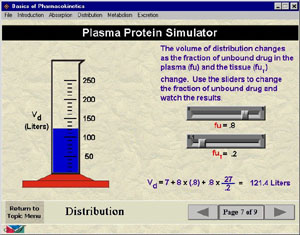The University Record, November 8, 1999 By Nancy Ross-Flanigan
News and Information Services

With new medicines constantly coming on the market, it’s more important than ever that pharmacists understand what happens as drugs pass through the body. Professional pharmacy students, who ultimately will work in hospitals, retail pharmacies and pharmaceutical companies, learn about this in pharmacokinetics courses.
Pharmacokinetics explores such topics as how long a drug is active in the body, what dose a patient should receive, how the drug should be administered and how the body eliminates the drug. Many of these concepts are difficult to understand when explained with only words or mathematical equations.
After taking a pharmacokinetics course, graduate student Nathan Teuscher developed the Michigan Applied Pharmacokinetics Computer Assisted Learning Modules, which uses interactive graphical models and animated illustrations to help get the ideas across.
“The idea behind it was that students learn in different manners,” Teuscher says. “In pharmacy, this subject has always been taught by lecture or by reading the material. We wanted to develop a Web program so that people could learn by doing it, if that is the way they need to learn. It is very interactive.”

Simulations of the liver, kidney and blood allow students to change various conditions and see how drug levels fluctuate. Visual models, rather than conventional graphs, are used to illustrate mathematical relationships. In one example, the volume of water in a graduated cylinder, representing drug distribution in the body, rises and falls as students change the amount of unbound drug in the system.
Teuscher’s modules have been recognized by the Computerworld Smithsonian Program as worthy of inclusion in its Permanent Research Collection on Information Technology.
Teuscher says that the modules have been very positively reviewed on campus and will be used in a class for the first time winter term.
Modules are on the Web (www.oit.itd.umich.edu/projects/pharmacy/pkmodule), making them available to both students and practicing pharmacists at any time.

